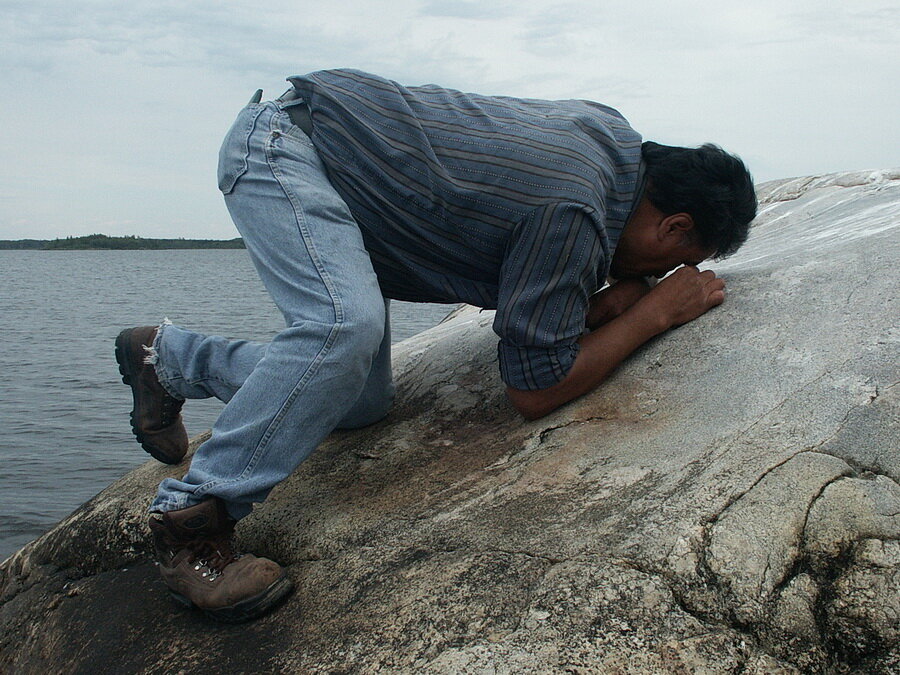Far North Friday #54: Things That Can Kill You
This is not strictly a far north story. It is more of a far north and a far south story.
Geologists try to get close to the rocks and soils they look at. But, in Australia, there are things that can kill you do that incorrectly.
In Canada, and many parts of the world, geologists assume a classic posture to examine rock or soil (Photo 1). We get down on our hands and knees, bum up, and nose pressed down against the rock or soil. Sometimes, we lie on the ground and use a magnifying lens to look closely at the material. We poke at, turn over, break, and pick up almost every rock sample we come across. We hold them close to our face to look at them. We stick our hands into dark crevices and pull out mineral crystals or small rock rock pieces. When we break open a rock, we may lick the fresh rock surface to get a different view. When working with soils, we may put some soil into our mouth to get a sense of how small the individual soil grains are. And you thought geologists were normal?
Photo 1: Andy Yesno (Eabametoong First Nation) displays the classic geologist posture while looking at geology near his community of Fort Hope, in the homeland of Eabametoong First Nation, Ontario, Canada. Photo composed by Andy Fyon, Aug 25/03.
In 1988, some colleagues and I attended an international conference in Australia. We survived the 26 hour flight across the Pacific. We survived being sprayed by insecticide just before landing in Australia. We survived the jet-lag, after 2 or 3 days of enduring a cloudy brain. But, we almost didn’t survive our first 2 minutes on the outback.
We visited an area near Kambalda, in Western Australia. At our first stop, we piled out of the vehicles, eager to see some world renowned Australian geology. The Canadian geologists immediately assumed our rock examination postures. Then we heard a yell “STOP”. Not only had our Australian geologist guide yelled at us, but he looked a little pale - like a white sheet. We froze. He explained. In Australia, almost every insect, spider, snake, reptile, and salt water crocodile could kill you in about 3 seconds if it attacked you. Some could kill you just by looking sideways at you, so they said! He had our full attention. Fearlessly poking into rock piles, rolling over, and cavalierly picking up rocks off the desert surface was a sure way to test the Australian medical system. Given our location on the outback, medical service was not an option.
After our sobering warning, we assumed a rather different rock examination approach (Photo 2). We stood together - safety in numbers! Rather than get too close to the rock, some of us resorted to using our telephoto lenses to examine the rock - safely at a distance! If the stop looked particularly threatening, we asked our Australian guide to stomp around in the area, so as to exercise away all dangerous life forms. We watched tentatively and took bets on his survival likelihood. Only then would we shuffle over, together, like we were all chained together.
Photo 2: The group of Canadian and Australian geologists looking at some Australian rock geology in the outback. After a warning about dangerous insects and snakes issued by our Australian field guide, we assumed a more cautious approach to looking at the geology - standing in groups (safety in numbers) and using telephoto camera lenses (safety in distance) allowing us to remain at a safe distance from killing life forms. I exaggerate just a bit :) . Photo composed by Andy Fyon, Kambalda area, Western Australia, 1988.
Now, I may exaggerate just a little bit. My exact recollection may have become embellished over time. But I never again complained about the things that can bother you in Canada (except the Polar bear). And oh yes, we all survived the Australian tour, despite the things that may kill you.
Have A Question About This Note?
Feb. 5/21 (Facebook Feb. 5/21).


